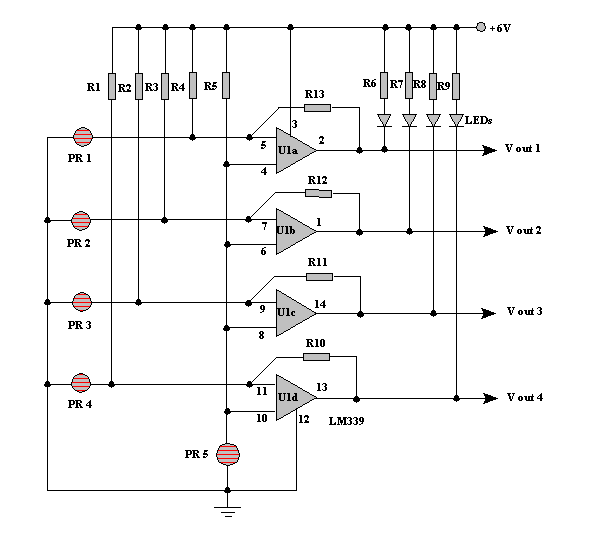| Schematic of photocell eyes: |
| Circuit Operation: |
| Referring to the schematic below, PR1 to PR5 are photoresistors sensitive to changes in light intensity. In low light or darkness these will have a high resistance of 1 meg ohm or so and dropping to just hundreds of ohms in bright light. |
 |
| PR5 sets the reference voltage or trip piont of the LM339 comparators, which is determined by the ambient lighting of the room or area. PR1 to PR4 are the light detectors that supply the input (V in) to the comparators. Because the reference voltage is set by PR5, each comparator will only light its corresponding LED when the light intensity on these detectors exceed the ambient light of the room or area. |
| Because of the way these photoresistors are arranged, each photoresistor detects light only in its respective quadrant ( Check back to CAD drawing of Ostron eye). For example the photoresistors in the top right quadrant which are all connected to each other in parallel will respond to any light that exceeds the ambient reference lighting ( Voltage) set by PR5 but only in its own quadrant. This is also true for the other three with respect to their quadrants. |
| With this arragement of photoresistors in separate quadrants, the eyes have the ability to control the motors that move the robot head. Staying with our previous example of the top right quadrant, any light from the scene in front of the eyes that exceeds the ambient reference in this quadrant will cause an output "high" from its respective comparator and this will turn on the motor that causes the robot head to move in the opposite direction , we must recall that the image displayed on this artificial retina is inverted and shifted left to right because of the focusing lens. |
| Schematic Diagram: |
| Parts List: |
| 4 0.2 in. diameter Photoresistors ( PR1 to PR 4) 1 0.4 in. diameter Photoresistor ( PR5) 5 22 K Resistors 1/4 watt ( R1 to R5) 4 2.2 K Resistors 1/4 watt ( R6 to R9) 4 1 Meg Resistors 1/4 watt ( R10 to R13) 4 LEDs 1 LM339 comparator IC ( U1a-d) |